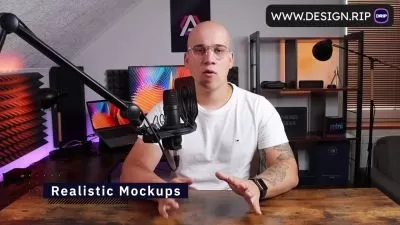Inclusive UX Writing: Physical Abilities & Neurodivergence
Dr. Katharina Grimm
2:32:59
Description
Writing For A Diverse Audience – Part 1
What You'll Learn?
- Understand what inclusion is and what inclusive UX Writing is
- Understand the difference between inclusion and accessibility
- Understand the concepts of bias and discrimination
- Know about different forms of discrimination
- Understand ableism in the tech industry and in UX
- Understand barriers to inclusion of users with physical disabilities in UX
- Know about inclusive and non-inclusive UX Writing for users with physical disabilities
- Understand how to write accessible on-screen text and alt text
- Understand how to write inclusive UX Copy for users with physical disabilities
- Define neurodivergence
- Understand neuro-discrimination in the tech industry and in UX
- Understand barriers to inclusion of neurodivergent users in UX
- Know about inclusive and non-inclusive UX Writing for neurodivergent users
- Understand how to write inclusive UX Copy for neurodivergent users
Who is this for?
What You Need to Know?
More details
DescriptionNaturally, inclusion plays a major role in UX Writing, because our UX copy cannot fulfill its purpose of creating a great user experience if it only works for a small elite of users. Instead, it should be readable, comprehensible, and respectful to users - regardless of their abilities.
However, many digital products still lack accessibility and inclusion: Not only does a lack of accessibility often give users with a disability or neurodivergent users a hard time. Also, the use of ableist language is still widespread.
But:
What are the effects of systemic ableism on the tech and UX industry?
What does ability-based discrimination actually look like in UX design and UX copy?
How can we ensure that our UX copy is inclusive of users with a disability and neurodivergent user?
If you ask yourself these and other questions and have not yet found an answer to them, this course is the right choice for you!
This course is the first part of a short series about inclusive UX Writing.
This course is about how to write inclusive UX copy for users with physical disabilities and neurodivergent users.
The next course is about how to write gender-inclusive, anti-racist and age-inclusive UX copy.
Who should join
This course is a great choice for all UX Writers and for people who work with UX Writing, including UX and UI designers, developers, product owners, and project managers. It could be helpful to know what UX Writing is and what it is used for, so if you are a complete beginner, you may think about first checking out my introductory course here on Udemy.
What you will learn
In the first section of this class, you will learn
what inclusion is and what inclusive UX Writing is
what discrimination and biases are
about different forms of discrimination
In the second section of this class, you will learn
what ableism and discrimination against people with physical disabilities are
about different models of physical disability
the relationship between tech, UX, and physical disability
how to write inclusive UX copy for users with physical disabilities
In the third section of this class, you will learn
what neurodivergence is
about different forms of neurodivergence
the relationship between tech, UX, and neurodivergence
how to write inclusive UX copy for neurodivergent
Sounds good? Then join this class and learn how to write inclusive UX copy!
Who this course is for:
- UX Writers
- Content Designers and Content Strategists
- Everybody who wants to transition into UX Writing
- Copywriters, journalists, and other professionals who are working on transitioning into UX Writing but would love to learn more about UX Writing
- Designers, developers, and project managers who want to integrate UX Writing into their team
- Everybody who is interested in this topic!
Naturally, inclusion plays a major role in UX Writing, because our UX copy cannot fulfill its purpose of creating a great user experience if it only works for a small elite of users. Instead, it should be readable, comprehensible, and respectful to users - regardless of their abilities.
However, many digital products still lack accessibility and inclusion: Not only does a lack of accessibility often give users with a disability or neurodivergent users a hard time. Also, the use of ableist language is still widespread.
But:
What are the effects of systemic ableism on the tech and UX industry?
What does ability-based discrimination actually look like in UX design and UX copy?
How can we ensure that our UX copy is inclusive of users with a disability and neurodivergent user?
If you ask yourself these and other questions and have not yet found an answer to them, this course is the right choice for you!
This course is the first part of a short series about inclusive UX Writing.
This course is about how to write inclusive UX copy for users with physical disabilities and neurodivergent users.
The next course is about how to write gender-inclusive, anti-racist and age-inclusive UX copy.
Who should join
This course is a great choice for all UX Writers and for people who work with UX Writing, including UX and UI designers, developers, product owners, and project managers. It could be helpful to know what UX Writing is and what it is used for, so if you are a complete beginner, you may think about first checking out my introductory course here on Udemy.
What you will learn
In the first section of this class, you will learn
what inclusion is and what inclusive UX Writing is
what discrimination and biases are
about different forms of discrimination
In the second section of this class, you will learn
what ableism and discrimination against people with physical disabilities are
about different models of physical disability
the relationship between tech, UX, and physical disability
how to write inclusive UX copy for users with physical disabilities
In the third section of this class, you will learn
what neurodivergence is
about different forms of neurodivergence
the relationship between tech, UX, and neurodivergence
how to write inclusive UX copy for neurodivergent
Sounds good? Then join this class and learn how to write inclusive UX copy!
Who this course is for:
- UX Writers
- Content Designers and Content Strategists
- Everybody who wants to transition into UX Writing
- Copywriters, journalists, and other professionals who are working on transitioning into UX Writing but would love to learn more about UX Writing
- Designers, developers, and project managers who want to integrate UX Writing into their team
- Everybody who is interested in this topic!
User Reviews
Rating
Dr. Katharina Grimm
Instructor's Courses
Udemy
View courses Udemy- language english
- Training sessions 18
- duration 2:32:59
- English subtitles has
- Release Date 2022/11/17














